Friction in Oil-Lubricated Rolling–Sliding Contacts with Technical and High-Performance Thermoplastics †
Abstract
1. Introduction
2. Materials and Methods
2.1. Experimental Configuration
2.2. Thermoplastics
2.3. Test Specimens
2.4. Lubricants
2.5. Operating Conditions
3. Results
3.1. Influence of Contact Configuration
3.2. Influence of Thermoplastic Material
3.3. Influence of Lubricant
3.4. Influence of Load
3.5. Influence of Oil Temperature
3.6. Influence of Surface Roughness
3.7. Summary of Results
4. Discussion
4.1. Influence of Contact Configuration
4.2. Influence of Thermoplastic Material
4.3. Influence of Lubricant
4.4. Influence of Load and Oil Temperature
4.5. Influence of Surface Roughness
5. Conclusions
- In thermoplastic EHL contacts, both sliding and rolling friction contributed significantly to the total friction, contrasting plain steel contact configurations, in which sliding friction dominated.
- The sliding friction was low for all contact configurations with thermoplastics compared to the plain steel contact configuration at the same normal load, thus showing the potential frictional advantages of using thermoplastic materials.
- For the operating conditions studied, the rolling friction for the contact configurations with PA12 and PA46 was approximately twice that of the contact configurations with PEEK and POM.
- Despite the different contact geometries, the difference in sliding and rolling friction was small between the contact configurations of steel/PEEK and PEEK/steel.
- The sliding friction is only a little influenced by the oil type, load, and thermoplastic material. A lower sliding friction is achieved by a lower Young modulus and a lower oil viscosity.
- The rolling friction is highly dependent on the thermoplastic material, oil type, oil viscosity, and load. A lower rolling friction is achieved by a higher normal load and a lower oil viscosity.
- Friction in oil-lubricated thermoplastic EHL contacts shows the potential for superlubricity with a coefficient of friction less than 0.01.
- The total friction increases drastically compared to fluid film lubrication.
- The rolling friction is only slightly influenced, but the sliding friction is strongly increased. This is attributed to the high solid friction caused by surface interactions.
- POM and PEEK have the lowest friction, and PA12 and PA46 have the highest friction in mixed and boundary lubrication.
Author Contributions
Funding
Data Availability Statement
Acknowledgments
Conflicts of Interest
Nomenclature
| Young’s modulus in N/m2 | |
| Normal force in N | |
| Friction force in N | |
| Slide-to-roll ratio | |
| Rolling speed in m/s | |
| Sliding velocity in m/s | |
| Surface velocity of solid body in m/s | |
| Arithmetic average height of body in μm | |
| Thermal effusivity in J/(K·m2·s1/2) | |
| Specific thermal capacity in J/(kg·K) | |
| Viscosity index | |
| Hertzian pressure in N/mm2 | |
| Greek symbols | |
| Thermal conductivity in W/(m·K) | |
| Coefficient of friction | |
| Poisson’s ratio|kinematic viscosity in mm/s2 | |
| Temperature in °C | |
| Glass transition regime in °C | |
| Density in g/cm³ | |
| Oil temperature in °C | |
| Mean coefficient of friction | |
| Relative change in test run 2 with respect to test run 1 | |
| Indices | |
| Test run 1 | |
| Test run 2 (repetition) | |
| r | Rolling |
| s | Sliding |
| oil | Oil |
Appendix A
| Figure 5a | Figure 5b | Figure 5c | Figure 5d | Figure 5e | Figure 5f | |
| 100Cr6/100Cr6 | 3.8% | 7.9% | −14.9% | 5.3% | 5.9% | −10.5% |
| PEEK/100Cr6 | −1.9% | 8.7% | −9.8% | 0.0% | 4.1% | −12.9% |
| 100Cr6/PEEK | −4.4% | −0.5% | −10.9% | 0.2% | 3.5% | −10.1% |
| PEEK/PEEK | 0.7% | 1.9% | −4.9% | 14.5% | 21.5% | −10.5% |
| Figure 6a | Figure 6b | Figure 6c | Figure 6d | Figure 6e | Figure 6f | |
| 100Cr6/PEEK | −4.4% | −0.5% | −10.9% | 0.2% | 3.5% | −10.1% |
| 100Cr6/PA12 | 2.8% | 8.6% | 3.9% | 3.7% | −0.6% | 9.4% |
| 100Cr6/PA46 | −9.5% | −3.8% | −13.5% | −10.3% | −5.9% | −14.6% |
| 100Cr6/POM | 1.8% | −2.4% | 2.9% | 5.1% | 6.6% | 1.9% |
| Figure 7a | Figure 7b | Figure 7c | Figure 7d | Figure 7e | Figure 7f | |
| MIN100 | −4.4% | −0.5% | −10.9% | 0.2% | 3.5% | −10.1% |
| MIN32 | 0.6% | 8.1% | −9.5% | 22.9% | 28.5% | −8.5% |
| PAO100 | −6.5% | −2.4% | −10.8% | −5.2% | −3.7% | −8.0% |
| PAGW100 | −5.6% | −2.2% | −6.9% | −3.9% | −3.7% | 17.4% |
| Figure 8a | Figure 8b | Figure 8c | Figure 8d | Figure 8e | Figure 8f | |
| = 10 N | −6.5% | 2.2% | −12.2% | −1.8% | 1.8% | −9.4% |
| = 20 N | −4.4% | −0.5% | −10.9% | 0.2%% | 3.5% | −10.1% |
| = 30 N | −2.1% | 3.6% | −9.9% | 5.5%% | 7.6% | 1.8% |
| Figure 9a | Figure 9b | Figure 9c | Figure 9d | Figure 9e | Figure 9f | |
| −4.4% | −0.5% | −10.9% | 1.5% | 3.5% | −10.1% | |
| −4.8% | 3.9% | −15.7% | 7.8% | 13.1% | −10.4% | |
| 7.9% | 19.7% | −7.2% | 26.4% | 30.4% | 1.5% | |
| Figure 10a | Figure 10b | Figure 10c | Figure 10d | Figure 10e | Figure 10f | |
| Ra < 0.02 μm | −4.4% | −0.5% | −10.9% | 0.2% | 3.5% | −10.1% |
| Ra ≈ 0.25 μm | −15.1% | −24.6% | 0.6% | −3.7% | −3.5% | −0.6% |
| Ra ≈ 0.50 μm | −24.8% | −24.8% | 38.9% | −4.1% | −4.7% | 35.8% |
References
- de Vicente, J.; Stokes, J.R.; Spikes, H.A. The Frictional Properties of Newtonian Fluids in Rolling–Sliding soft-EHL Contact. Tribol. Lett. 2005, 20, 273–286. [Google Scholar] [CrossRef]
- de Vicente, J.; Stokes, J.R.; Spikes, H.A. Rolling and sliding friction in compliant, lubricated contact. Proc. Inst. Mech. Eng. Part J J. Eng. Tribol. 2006, 220, 55–63. [Google Scholar] [CrossRef]
- Reitschuster, S.; Maier, E.; Lohner, T.; Stahl, K. Friction and Temperature Behavior of Lubricated Thermoplastic Polymer Contacts. Lubricants 2020, 8, 67. [Google Scholar] [CrossRef]
- VDI 2736 Blatt 2:2014-06; Thermoplastische Zahnräder. Stirnradgetriebe. Tragfähigkeitsberechnung. Verein Deutscher Ingenieure: Düsseldorf, Germany, 2014.
- Johnson, K.L. Regimes of Elastohydrodynamic Lubrication. J. Mech. Eng. Sci. 1970, 12, 9–16. [Google Scholar] [CrossRef]
- Myers, T.G.; Hall, R.W.; Savage, M.D.; Gaskell, P.H. The transition region of elastohydrodynamic lubrication. Proc. R. Soc. Lond. A 1991, 432, 467–479. [Google Scholar] [CrossRef]
- Marx, N.; Guegan, J.; Spikes, H.A. Elastohydrodynamic film thickness of soft EHL contacts using optical interferometry. Tribol. Int. 2016, 99, 267–277. [Google Scholar] [CrossRef]
- Myant, C.; Spikes, H.A.; Stokes, J.R. Influence of load and elastic properties on the rolling and sliding friction of lubricated compliant contacts. Tribol. Int. 2010, 43, 55–63. [Google Scholar] [CrossRef]
- Stupkiewicz, S.; Lengiewicz, J.; Sadowski, P.; Kucharski, S. Finite deformation effects in soft elastohydrodynamic lubrication problems. Tribol. Int. 2016, 93, 511–522. [Google Scholar] [CrossRef]
- Hooke, C.J.; O’Donoghue, J.P. Elastohydrodynamic Lubrication of Soft, Highly Deformed Contacts. J. Mech. Eng. Sci. 1972, 14, 34–48. [Google Scholar] [CrossRef]
- Esfahanian, M.; Hamrock, B.J. Fluid-Film Lubrication Regimes Revisited. Tribol. Trans. 1991, 34, 628–632. [Google Scholar] [CrossRef]
- Hooke, C.J. The Elastohydrodynamic Lubrication of Heavily Loaded Contacts. J. Mech. Eng. Sci. 1977, 19, 149–156. [Google Scholar] [CrossRef]
- Hofmann, S.; Maier, E.; Lohner, T. In Situ Contact Analysis of Polyetheretherketone under Elastohydrodynamic Lubrication. Polymers 2022, 14, 4398. [Google Scholar] [CrossRef] [PubMed]
- Maier, E.; Ziegltrum, A.; Lohner, T.; Stahl, K. Characterization of TEHL contacts of thermoplastic gears. Forsch. Ingenieurwes. 2017, 81, 317–324. [Google Scholar] [CrossRef]
- Ziegltrum, A.; Maier, E.; Lohner, T.; Stahl, K. A Numerical Study on Thermal Elastohydrodynamic Lubrication of Coated Polymers. Tribol. Lett. 2020, 68, 71. [Google Scholar] [CrossRef]
- Hunter, S.C. The Rolling Contact of a Rigid Cylinder with a Viscoelastic Half Space. J. Appl. Mech. 1961, 28, 611–617. [Google Scholar] [CrossRef]
- Hooke, C.J.; Huang, P. Elastohydrodynamic lubrication of soft viscoelastic materials in line contact. Proc. Inst. Mech. Eng. Part J J. Eng. Tribol. 1997, 211, 185–194. [Google Scholar] [CrossRef]
- Putignano, C.; Dini, D. Soft Matter Lubrication: Does Solid Viscoelasticity Matter? ACS Appl. Mater. Interfaces 2017, 9, 42287–42295. [Google Scholar] [CrossRef] [PubMed]
- Zhao, Y.; Liu, H.C.; Morales-Espejel, G.E.; Venner, C.H. Effects of solid viscoelasticity on elastohydrodynamic lubrication of point contacts. Tribol. Int. 2022, 171, 107562. [Google Scholar] [CrossRef]
- Krupka, J.; Dockal, K.; Krupka, I.; Hartl, M. Elastohydrodynamic Lubrication of Compliant Circular Contacts near Glass-Transition Temperature. Lubricants 2022, 10, 155. [Google Scholar] [CrossRef]
- Putignano, C.; Reddyhoff, T.; Carbone, G.; Dini, D. Experimental Investigation of Viscoelastic Rolling Contacts: A Comparison with Theory. Tribol. Lett. 2013, 51, 105–113. [Google Scholar] [CrossRef]
- Putignano, C.; Reddyhoff, T.; Dini, D. The influence of temperature on viscoelastic friction properties. Tribol. Int. 2016, 100, 338–343. [Google Scholar] [CrossRef]
- Carbone, G.; Putignano, C. A novel methodology to predict sliding and rolling friction of viscoelastic materials: Theory and experiments. J. Mech. Phys. Solids 2013, 61, 1822–1834. [Google Scholar] [CrossRef]
- Schmid, F.; Paschold, C.; Lohner, T.; Stahl, K. Characteristics in hard conformal EHL line contacts. Issues Lang. Teach. (ILT) 2023, 75, 730–740. [Google Scholar] [CrossRef]
- Sadowski, P.; Stupkiewicz, S. Friction in lubricated soft-on-hard, hard-on-soft and soft-on-soft sliding contacts. Tribol. Int. 2019, 129, 246–256. [Google Scholar] [CrossRef]
- Quinn, C.; Nečas, D.; Šperka, P.; Marian, M.; Vrbka, M.; Křupka, I.; Hartl, M. Experimental investigation of friction in compliant contact: The effect of configuration, viscoelasticity and operating conditions. Tribol. Int. 2022, 165, 107340. [Google Scholar] [CrossRef]
- Schmid, F.; Maier, E.; Lohner, T.; Stahl, K. Friction in Oil-lubricated Rolling-Sliding Contacts with Technical Thermoplastics: 64. In Proceedings of the Tribologie-Fachtagung 2023, Reibung, Schmierung und Verschleiß, Göttingen, Germany, 25–27 September 2023. [Google Scholar]
- Hofmann, S.; Lohner, T.; Stahl, K. Influence of water content on elastohydrodynamic friction and film thickness of water-containing polyalkylene glycols. Front. Mech. Eng. 2023, 9, 1128447. [Google Scholar] [CrossRef]
- Jain, M.; Patil, S. A review on materials and performance characteristics of polymer gears. Proc. Inst. Mech. Eng. Part C J. Mech. Eng. Sci. 2023, 237, 2762–2790. [Google Scholar] [CrossRef]
- Zhong, B.; Song, H.; Liu, H.; Wei, P.; Lu, Z. Loading capacity of POM gear under oil lubrication. J. Adv. Mech. Des. Syst. Manuf. 2022, 16, JAMDSM0006. [Google Scholar] [CrossRef]
- Hriberšek, M.; Kulovec, S. Thermal and durability characterization of polyacetal and polyamide gear pairs. J. Mech. Sci. Technol. 2021, 35, 3389–3394. [Google Scholar] [CrossRef]
- Md Ghazali, W.; Daing Idris, D.M.N.; Sofian, A.H.; Siregar, J.P.; Abdul Aziz, I.A. A review on failure characteristics of polymer gear. MATEC Web Conf. 2017, 90, 1029. [Google Scholar] [CrossRef]
- Kalin, M.; Kupec, A. The dominant effect of temperature on the fatigue behaviour of polymer gears. Wear 2017, 376–377 Pt B, 1339–1346. [Google Scholar] [CrossRef]
- Lagier, F.; Freund, N.; Bause, K.; Ott, S.; Albers, A. Simulation-based evaluation of high-speed PEEK gears in automotive powertrains and design of a validation environment for high-speed gears. In Dritev, Proceedings of the 22nd International VDI Congress, Baden, Germany, 6–7 July 2022; VDI Verlag: Düsseldorf, Germany, 2022; pp. 223–240. ISBN 9783181024010. [Google Scholar]
- Zorko, D.; Kulovec, S.; Duhovnik, J.; Tavčar, J. Durability and design parameters of a Steel/PEEK gear pair. Mech. Mach. Theory 2019, 140, 825–846. [Google Scholar] [CrossRef]
- Hoskins, T.J.; Dearn, K.D.; Chen, Y.K.; Kukureka, S.N. The wear of PEEK in rolling–sliding contact—Simulation of polymer gear applications. Wear 2014, 309, 35–42. [Google Scholar] [CrossRef]
- VDI 2736 Blatt 1:2016-07; VDI-Richtlinie 2736—Blatt 1: Thermoplastische Zahnräder. Werkstoffe, Werkstoffauswahl, Herstellverfahren, Herstellgenauigkeit, Gestalten. Verein Deutscher Ingenieure: Düsseldorf, Germany, 2016.
- Koplin, C.; Oehler, H.; Praß, O.; Schlüter, B.; Alig, I.; Jaeger, R. Wear and the Transition from Static to Mixed Lubricated Friction of Sorption or Spreading Dominated Metal-Thermoplastic Contacts. Lubricants 2022, 10, 93. [Google Scholar] [CrossRef]
- Brandão, J.A.; Meheux, M.; Seabra, J.H.O.; Ville, F.; Castro, M.J.D. Traction curves and rheological parameters of fully formulated gear oils. Proc. Inst. Mech. Eng. Part J J. Eng. Tribol. 2011, 225, 577–593. [Google Scholar] [CrossRef]
- Heathcote, H.L., Ed.; The Ball Bearing: In the Making, Under Test and on Service. Proc. Inst. Automob. Eng. 1920, 15, 569–702. [Google Scholar]
- Yilmaz, M.; Mirza, M.; Lohner, T.; Stahl, K. Superlubricity in EHL Contacts with Water-Containing Gear Fluids. Lubricants 2019, 7, 46. [Google Scholar] [CrossRef]
- Chang, L. A deterministic model for line-contact partial elastohydrodynamic lubrication. Tribol. Int. 1995, 28, 75–84. [Google Scholar] [CrossRef]
- Hultqvist, T. Transient Elastohydrodynamic Lubrication: Effects of Geometry, Surface Roughness, Temperature, and Plastic Deformation; Luleå University of Technology: Luleå, Sweden, 2020; ISBN 978-91-7790-604-9. [Google Scholar]
- Lates, M.T.; Velicu, R.; Gavrila, C.C. Temperature, Pressure, and Velocity Influence on the Tribological Properties of PA66 and PA46 Polyamides. Materials 2019, 12, 3452. [Google Scholar] [CrossRef]
- Jaeger, R.; Koplin, C.; Schluter, B. Lubricated polymer-steel-systems: Influence of the surface and interfacial energies of frictional partners on their tribological performance. In International Conference on Gears 2022; VDI Verlag: Düsseldorf, Germany, 2022; pp. 1223–1236. ISBN 9783181023891. [Google Scholar]
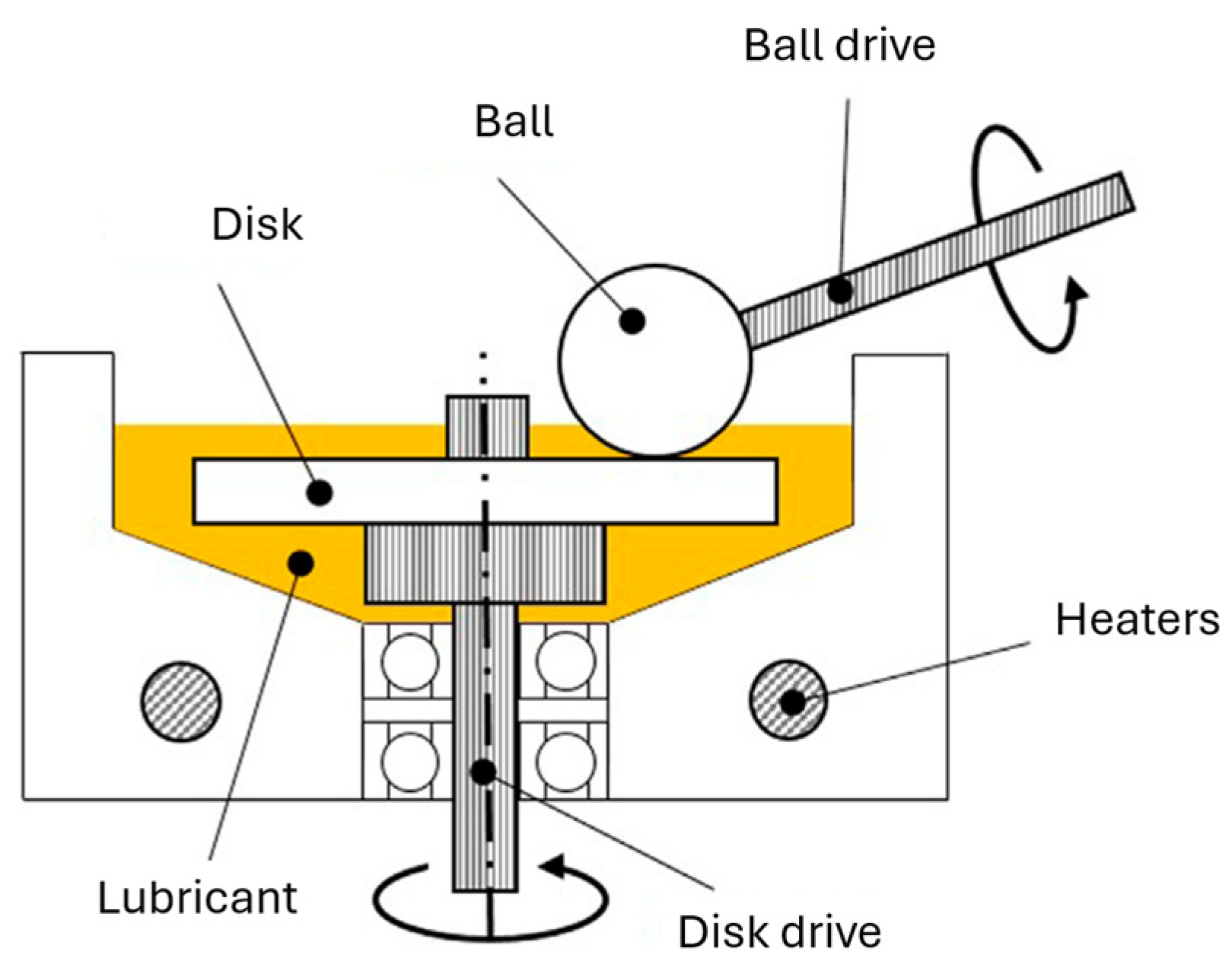
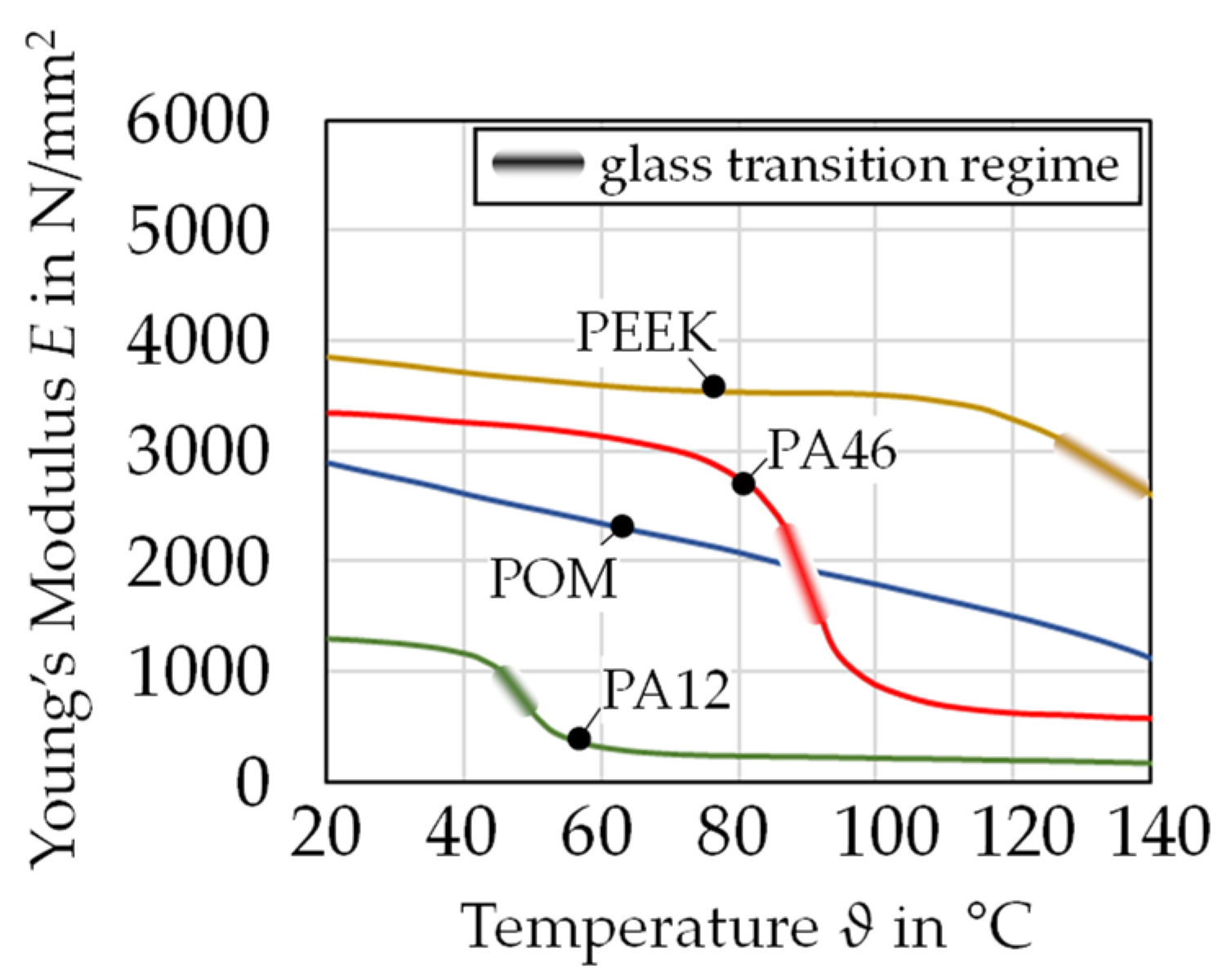






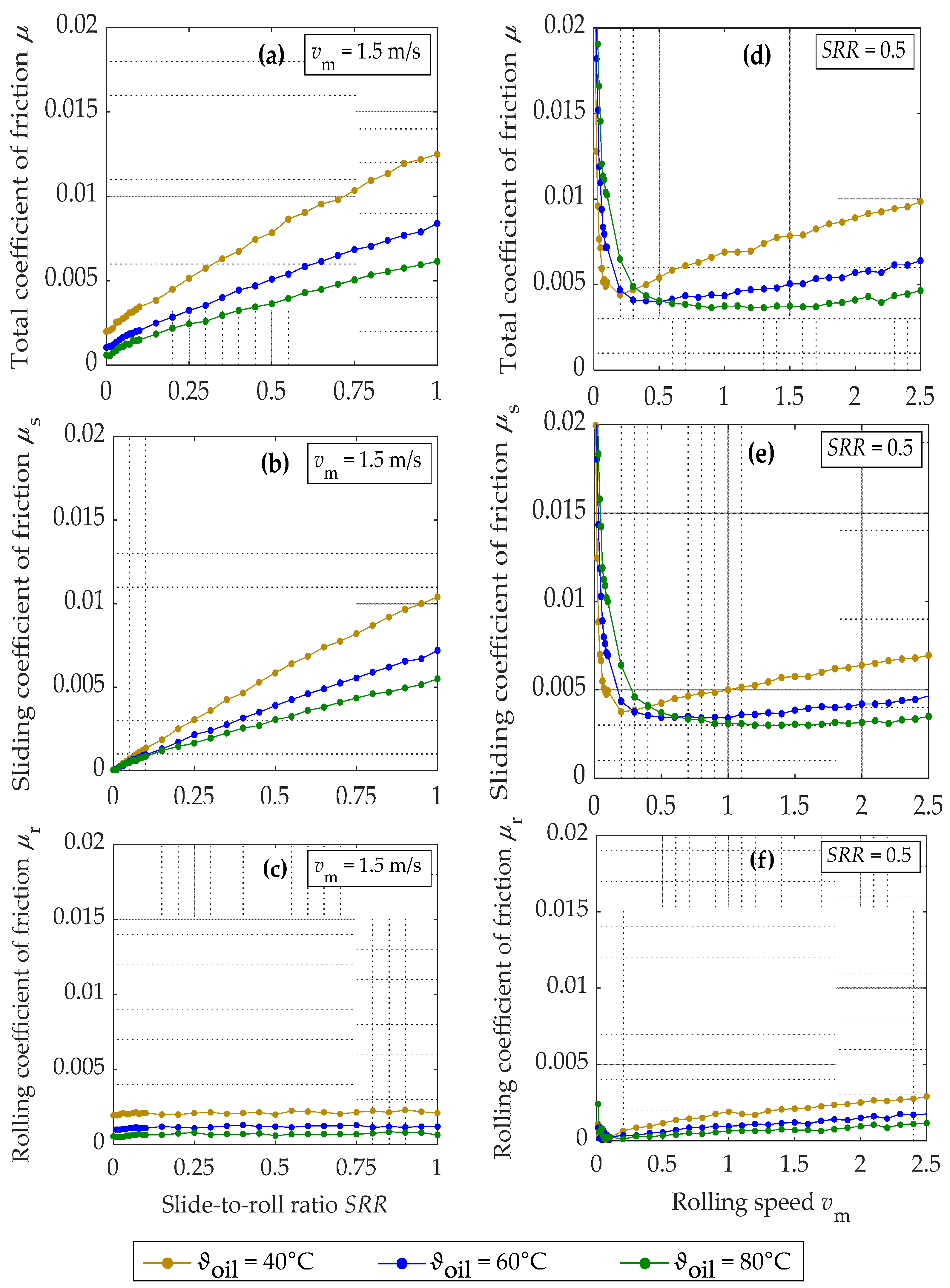
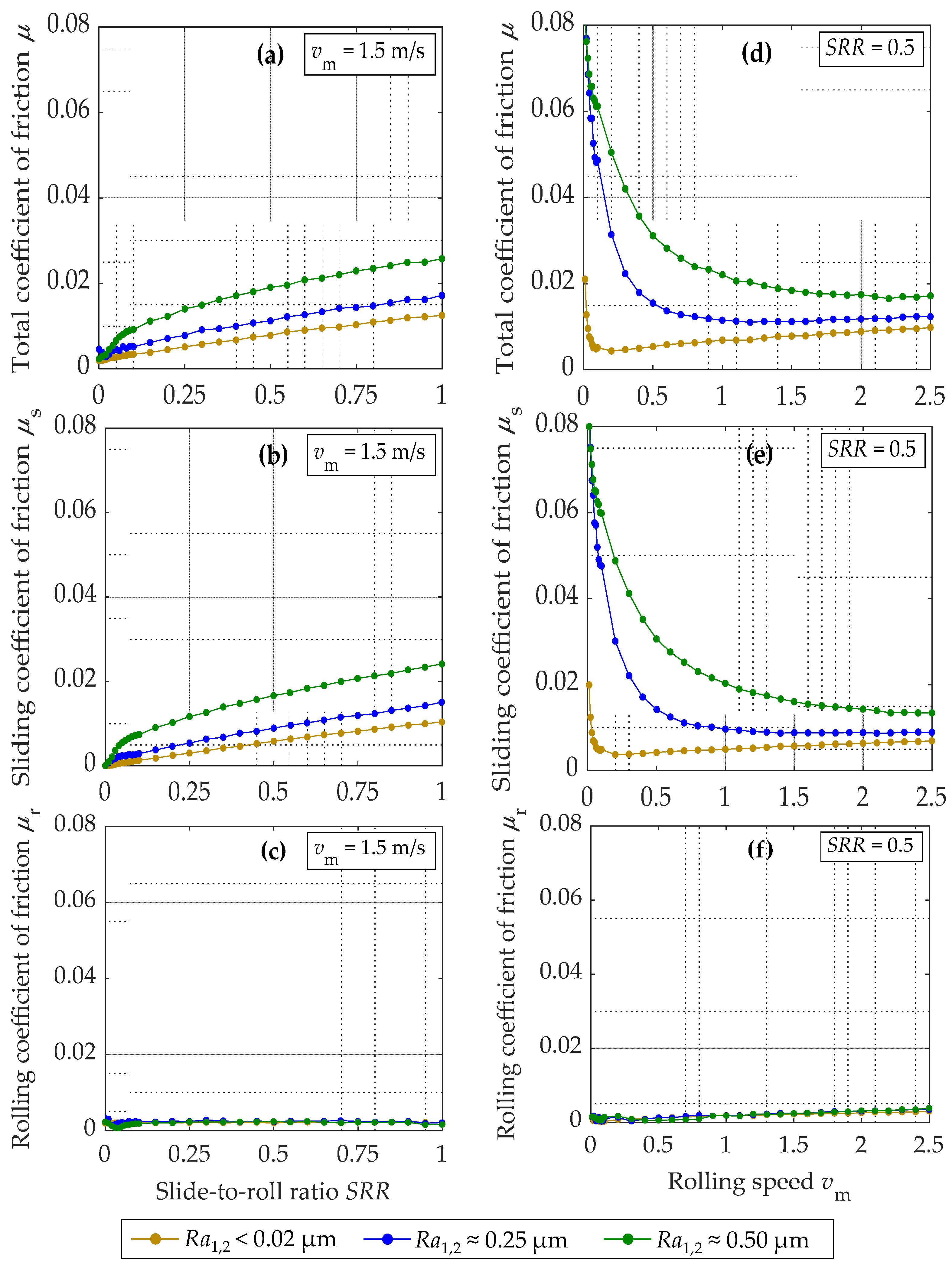
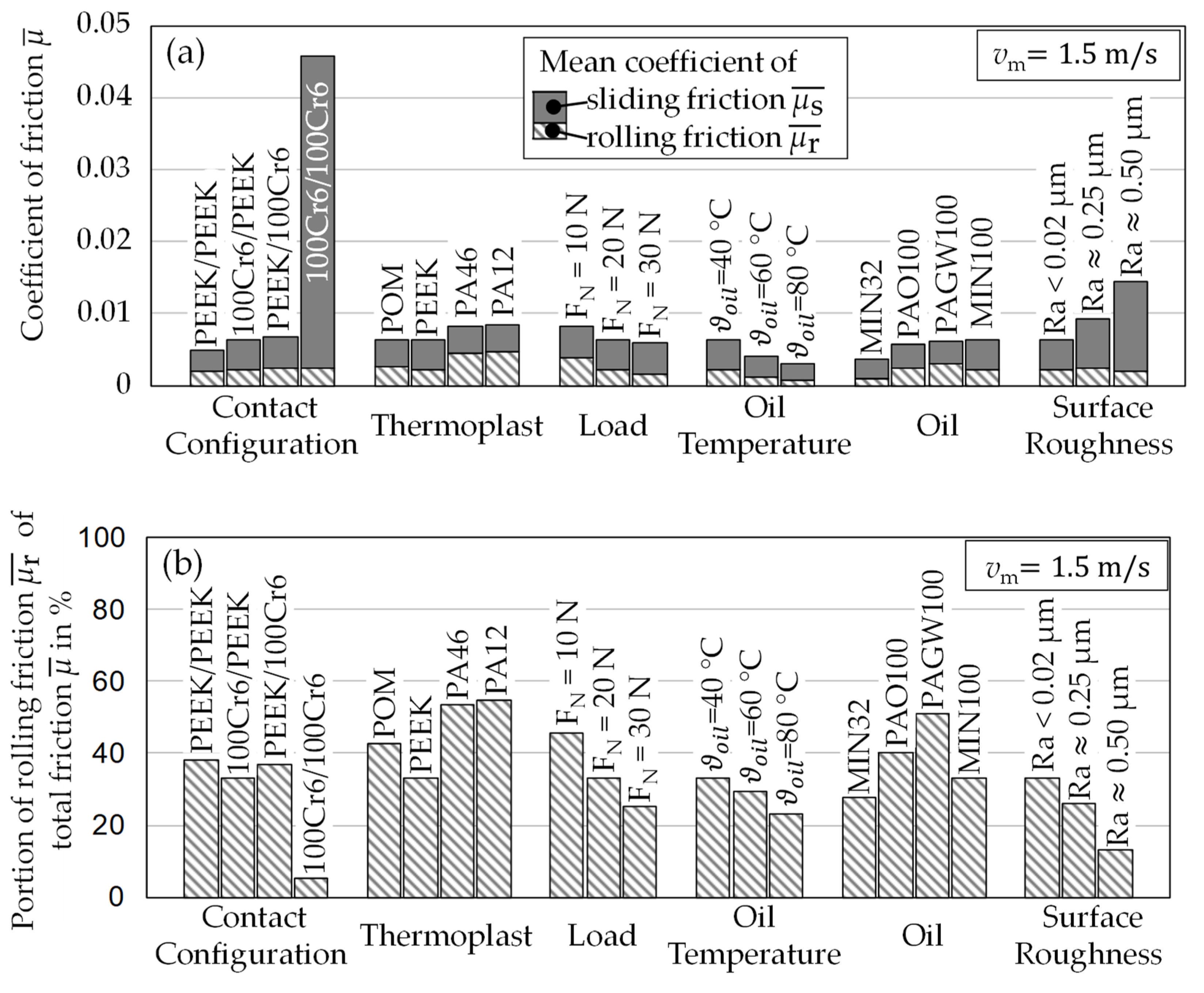

| PEEK | POM | PA12 | PA46 | ||
|---|---|---|---|---|---|
| (40 °C) | 3720 | 2615 | 1180 | 3260 | N/mm2 |
| (40 °C) | 0.4 | 0.42 | 0.37 1 | 0.37 | - |
| (40 °C) | 1.32 | 1.39 | 1.01 | 1.17 | g/cm3 |
| 145 | −60 | 45 | 75 | °C |
| MIN32 | MIN100 | PAO100 | PAGW100 | ||
|---|---|---|---|---|---|
| ISO VG class | ISO VG 32 | ISO VG 100 | ISO VG 100 | ISO VG 100 | – |
| 32.6 | 94.5 | 104.6 | 111.5 | mm/s2 | |
| 5.5 | 9.8 | 15.5 | 18.9 1 | mm/s2 | |
| 104 | 77 | 157 | 191 | – | |
| 0.887 | 0.885 | 0.852 | 1.126 | g/cm3 |
| 100Cr6/PEEK | 100Cr6/POM | 100Cr6/PA12 | 100Cr6/PA46 | ||
|---|---|---|---|---|---|
| 73.8 | 59.4 | 34.0 | 66.5 | ||
| 93.0 | 74.8 | 42.8 | 83.8 | ||
| 106.5 | 85.6 | 49.1 | 95.9 |
Disclaimer/Publisher’s Note: The statements, opinions and data contained in all publications are solely those of the individual author(s) and contributor(s) and not of MDPI and/or the editor(s). MDPI and/or the editor(s) disclaim responsibility for any injury to people or property resulting from any ideas, methods, instructions or products referred to in the content. |
© 2024 by the authors. Licensee MDPI, Basel, Switzerland. This article is an open access article distributed under the terms and conditions of the Creative Commons Attribution (CC BY) license (https://creativecommons.org/licenses/by/4.0/).
Share and Cite
Schmid, F.; Lohner, T.; Stahl, K. Friction in Oil-Lubricated Rolling–Sliding Contacts with Technical and High-Performance Thermoplastics. Lubricants 2024, 12, 372. https://doi.org/10.3390/lubricants12110372
Schmid F, Lohner T, Stahl K. Friction in Oil-Lubricated Rolling–Sliding Contacts with Technical and High-Performance Thermoplastics. Lubricants. 2024; 12(11):372. https://doi.org/10.3390/lubricants12110372
Chicago/Turabian StyleSchmid, Ferdinand, Thomas Lohner, and Karsten Stahl. 2024. "Friction in Oil-Lubricated Rolling–Sliding Contacts with Technical and High-Performance Thermoplastics" Lubricants 12, no. 11: 372. https://doi.org/10.3390/lubricants12110372
APA StyleSchmid, F., Lohner, T., & Stahl, K. (2024). Friction in Oil-Lubricated Rolling–Sliding Contacts with Technical and High-Performance Thermoplastics. Lubricants, 12(11), 372. https://doi.org/10.3390/lubricants12110372







